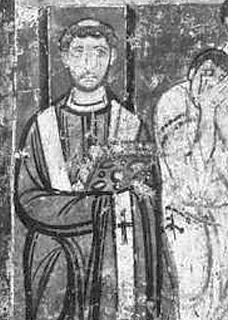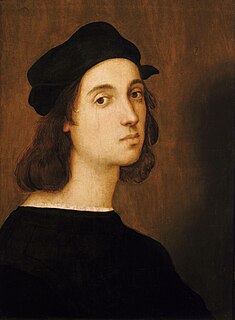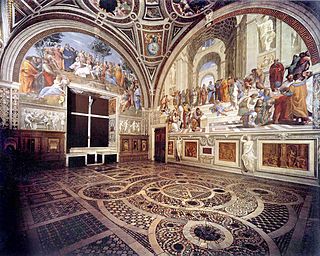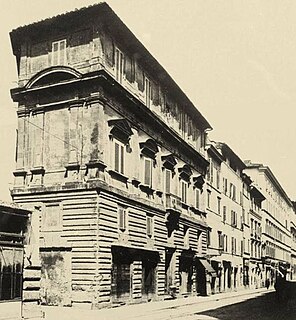
Pope Leo IV was the bishop of Rome and ruler of the Papal States from 10 April 847 to his death. He is remembered for repairing Roman churches that had been damaged during Arab raids on Rome, and for building the Leonine Wall around Vatican Hill. Pope Leo organized a league of Italian cities who fought and won the sea Battle of Ostia against the Saracens.

Raffaello Sanzio da Urbino, known as Raphael, was an Italian painter and architect of the High Renaissance. His work is admired for its clarity of form, ease of composition, and visual achievement of the Neoplatonic ideal of human grandeur. Together with Michelangelo and Leonardo da Vinci, he forms the traditional trinity of great masters of that period.

The Apostolic Palace is the official residence of the pope, the head of the Catholic Church, located in Vatican City. It is also known as the Papal Palace, the Palace of the Vatican and the Vatican Palace. The Vatican itself refers to the building as the Palace of Sixtus V, in honor of Pope Sixtus V, who built most of the present form of the palace.

The four Raphael Rooms form a suite of reception rooms in the Apostolic Palace, now part of the Vatican Museums, in Vatican City. They are famous for their frescoes, painted by Raphael and his workshop. Together with Michelangelo's Sistine Chapel ceiling frescoes, they are the grand fresco sequences that mark the High Renaissance in Rome.

The Leonine City is the part of the city of Rome which, during the Middle Ages, was enclosed with the Leonine Wall, built by order of Pope Leo IV in the 9th century.

Borgo is the 14th rione of Rome, Italy. It is identified by the initials R. XIV and is included within Municipio I.

The naval Battle of Ostia took place in 849 in the Tyrrhenian Sea between Muslim pirates and an Italian league of Papal, Neapolitan, Amalfitan, and Gaetan ships. The battle ended in favor of the Italian league, as they defeated the pirates. It is one of the few events to occur in southern Italy during the ninth century that is still commemorated today, largely through the walls named after Leo and for the Renaissance painting Battaglia di Ostia by Raphael.
The Arab raid against Rome took place in 846. Muslim raiders plundered the outskirts of the city of Rome, sacking the basilicas of Old St Peter's and St Paul's-Outside-the-Walls, but were prevented from entering the city itself by the Aurelian Walls.

The Madonna della Seggiola or The Madonna della Sedia is an oil on panel Madonna painting by the High Italian Renaissance artist Raphael, executed c. 1513–1514, and housed at the Palazzo Pitti Collection in Florence, Italy. Although there is documentation on its arrival to its current location, Palazzo Pitti, it is still unknown who commissioned the painting; however, it has been in the Medici family since the 16th century.

The Fire in the Borgo is a painting created by the workshop of the Italian Renaissance artist Raphael between 1514 and 1517. Though it is assumed that Raphael did make the designs for the complex composition, the fresco was most likely painted by his assistant Giulio Romano. The painting was part of Raphael's commission to decorate the rooms that are now known as the Stanze di Raffaello, in the Apostolic Palace in the Vatican. It depicts Pope Leo IV halting a fire in 847 with a benediction from a balcony in front of the Old St. Peter's Basilica. The mural lends its name to the Stanza dell'incendio del Borgo.

The Coronation of Charlemagne is a painting by the workshop of the Italian Renaissance artist Raphael. Though it is believed that Raphael did make the designs for the composition, the fresco was probably painted by Gianfrancesco Penni. The painting was part of Raphael's commission to decorate the rooms that are now known as the Stanze di Raffaello, in the Apostolic Palace in the Vatican. It is located in the room that was named after The Fire in the Borgo, the Stanza dell'incendio del Borgo.

The Oath of Leo III is a painting by the workshop of the Italian renaissance artist Raphael. The painting was part of Raphael's commission to decorate the rooms that are now known as the Stanze di Raffaello, in the Apostolic Palace in the Vatican. It is located in the room that was named after The Fire in the Borgo, the Stanza dell'incendio del Borgo. In the fresco, Pope Leo III is seen during the trial on December 23 AD 800 during which he was brought face to face with the nephews of his predecessor Pope Hadrian I, who had accused him of misconduct. The assembled bishops declared that they could not judge the pope, after which Leo took an oath of purgation of his own free will.

Ostia Antica is the 35th zona of Rome, Italy, four kilometers away from the coast. It is identified by the initials Z. XXXV and it is distinct from Ostia. Ostia Antica belongs to Municipio X.

The Meeting of Leo I and Attila is a fresco by the Italian Renaissance artist Raphael. It was painted from 1513 to 1514 as part of Raphael's commission to decorate the rooms that are now known as the Stanze di Raffaello, in the Apostolic Palace in the Vatican. It is located in the Stanza di Eliodoro, which is named after The Expulsion of Heliodorus from the Temple.

The Renaissance in Rome occupied a period from the mid-15th to the mid-16th centuries, a period which spawned such masters as Michelangelo and Raphael, who left an indelible mark on Western figurative art. The city had been a magnet for artists wishing to study its classical ruins since the early 1400s. A revived interest in the Classics brought about the first archaeological study of Roman remains by the architect Filippo Brunelleschi and sculptor Donatello. This inspired a corresponding classicism in painting and sculpture, which manifested itself in the paintings of Masaccio and Uccello. Pisanello and his assistants also frequently took inspiration from ancient remains, but their approach was essentially cataloguing, acquiring a repertoire of models to be exploited later.

The Papal Navy was the maritime force of the Papal States. Loosely construed, it was in sporadic existence from approximately the Battle of Ostia (849) during the pontificate of Leo IV until the ascension of Pope Leo XIII in 1878.

The Basilica of Santa Aurea is a church situated in the Ostia Antica district of Ostia, Italy. Ostia became an episcopal see as early as the 3rd century AD. The present-day church, completed in 1483, it was the seat of the suburbicarian diocese of Ostia until 1966, when Ostia became part of the diocese of Rome.

Palazzo Jacopo da Brescia was a Renaissance palace in Rome, Italy, which was located in the Borgo rione.

Palazzo dei Convertendi is a reconstructed Renaissance palace in Rome. It originally faced the Piazza Scossacavalli, but was demolished and rebuilt along the north side of Via della Conciliazione, the wide avenue constructed between 1936 and 1950, which links St Peter's Basilica and the Vatican City to the centre of Rome. The palace is famous as the last home of the painter Raphael, who died there in 1520.

Borgo Nuovo, originally known as via Alessandrina, also named via Recta or via Pontificum, was a road in the city of Rome, Italy, important for historical and architectural reasons. Built by Pope Alexander VI Borgia for the holy year of 1500, the road became one of the main centers of the high Renaissance in Rome. Borgo Nuovo was demolished together with the surrounding quarter in 1936–37 due to the construction of Via della Conciliazione.



















